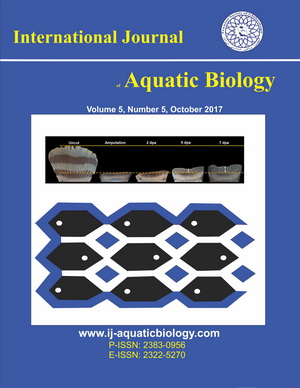Reproductive biology of the Guinean amberjack, Seriola carpenteri (Mather, 1971) in the exclusive economic zone (EEZ) of Côte d'Ivoire
Downloads
The reproduction of Seriola carpenteri (Mather, 1971) was studied from August 2017 to July 2018 in the Ivorian Exclusive Economic Zone (EEZ) based on samples from artisanal fishing at the Abobo-Doumé canoe dock. A total of 360 specimens, including 197 males and 163 females, were examined. The sex ratio is 1:1. The monthly monitoring of the Gonado-Somatic Index (GSI) and the stages of sexual maturity revealed that S. carpenteri reproduces twice a year in all seasons. The first period extends from September to January, and the second runs from March to June. The Hepato-Somatic Index (HSI) indicates that S. carpenteri is a lean fish. The size of the first sexual maturity (L50) of the S. carpenteri population is 30.43 cm, with males reaching 30.77 cm and females 30.05 cm. Absolute fecundity varies from 27,750 to 225,330 oocytes for weights ranging from 300.2 to 935 g, with standard lengths ranging from 22.8 to 36.2 cm. Relative fecundity ranges between 68 and 254 oocytes per gram of body weight. Seriola carpenteri exhibits high reproductive success due to its low atresia rate of 19.32%. The database formed by the results of this study could serve as a basis for the domestication of this species in the marine ecosystem, aiming for greater availability of animal protein and rational exploitation of this fishery resource.
Downloads
Aka Z., Koç H.T., Turan C. (2004). A study on the anchovy Engraulis encrasicolus, Linnaeus (1758) in Turkish Seas, Turkey. Pakistan Journal Biology Sciences, 7: 1121-1126.
Amira S., Alioua Z., Harchouche K. (2019). Gonadal development and fecundity of bogue Boops boops (Linnaeus, 1758) on the central Algerian coast. Turkish Journal of Zoology, 43: 12-29.
Arfi R., Pezennec O., Cissoko S., Mensah M. (1991). Variations spatiale et temporelle de la résurgence ivoiro-ghanéenne. Orstom, Paris. pp: 162-172.
Assan N.F., Diaha N.C., Edoukou A., Kouamé J.P., N’Guessan Y., N’Da K. (2017). Biologie de la reproduction d’Elagatis bipinnulata (Guoy & Gaimard, 1824) capturé dans le golfe de guinée par la flottille artisanale en Côte d’ivoire. Journal Applied Biosciences, 113: 11208-11220.
Capapé C., Rafrafi-Nouira S., Diatta Y., Golani D. (2018). On the Mediterranean occurrence of Guinean amberjack Seriola carpenteri (Osteichthyes: Carangidae), with first confirmed record from the Tunisian coast. Cahier de Biologie?Marine, 59: 399-402.
Chemmam-Abdelkader B., Kraiem M.M., El Abed A. (2002). Période de ponte, sex-ratio et maturité sexuelle de Dentex maroccanus (Teleostei, Sparidae) des côtes Tunisiennes. Bulletin de l ’Institut National des Sciences et Technologies de la Mer de Salammbô, 29: 5-10.
Diaha N.C., N’DA K., Soro Y. (2010). Régime alimentaire de Scomberomorus tritor (Cuvier. 1831) dans le Golfe de Guinée. International Journal of Biological Chemistry, 4(3): 669-680.
Djadji G.L., Atse B.C., Sylla S., Konan K.J., Kouassi N.J. (2013). Reproduction du Mugilidae Mugil cephalus Linné, 1758 dans deux complexes lagunaires (lagunes Ebrié et de Grand-Lahou) de la Côte d’Ivoire. International Journal and Chemical Sciences, 7(4): 1701-1716.
Djagoua E.M.V. (2003). Contribution de l’imagerie Satellitaire Visible et Infra Rouge Thermique à l’étude de la variabilité du phénomène physique de surface de la mer : application à la variabilité du phytoplancton et des prises de Sardinella aurita. Thèse de Doctorat, Université de Cocody, Abidjan, Côte d’Ivoire. 136 p.
Djagoua E.V., Larouche P., Kassi J.B., Affian K., Saley B. (2011). Variabilité saisonnière et interannuelle de la concentration de la chlorophylle dans la zone côtière du golfe de Guinée à partir des images SeaWiFS. International Journal of Remote Sensing, 32(14): 3851-3874.
Fontana A. (1969). Etude de la maturité sexuelle des sardinelles, Sardinella eba et Sardinella aurita de la région de Pointe-Noire. Orstom, Série Océanographique, 7(2): 101-114.
Ghorbel M., Jarboui O., Bradai M.N., Bouain A. (1996). Détermination de la taille de première maturité sexuelle par une fonction logistique chez Limanda limanda, Pagellus erythrinus et Scorpaena porcus. Bulletin INSTM, n. spec. 3: 24-27.
Golani D., Orsi-Relini L., Massutí E., Quignard J-P. (2002). In: CIESM atlas of exotic species in the Mediterranean, vol 1, In: F Briand (Ed.), Fishes. Monaco. CIESM Publishers.
Gougnon A.R., Kouadio J.M., KASSI J.B., Mobio A.B., Djagoua E.V. (2018). Variabilité saisonnière et interannuelle de la salinité de surface de la mer du golfe ivoirien à l’aide de l’imagerie satellitaire de SMOS-MIRAS de la période 2010-2014. International Journal and Engineering, Science Invention, 7(8): 48-54.
Kao H.C., Chan T.Y., Yu H.P. (1999). Ovary development of the Deep-water Shrimp Aristaeomorpha Foliacea (Risso, 1826) (Crustacea: Decapoda: Aristeidae) from Taiwan. Zoological Studies, 38(4): 373-378.
Kartas F., Quignard J.P. (1984). La fécondité des poissons téléostéens, Collection de Biologie des Milieux Marins. Masson (Eds), Paris. 121 p
Khallaf E.A., Authman M.N. (2010). Some biological aspects of the Nile Mormirid fish (Mormyrus kannume, Forsskal, 1775) from Bahr Shebeen Nilotic Canal, Egypt. World Journal of Fish and Marine Sciences, 2: 357-375.
Konan Y.A. Ouattara S., Koné T., Bamba M., Koné I. (2013). Caractéristiques de la reproduction de Thysochromis ansorgii (Pisces, Cichlidae) dans la forêt des marais Tanoé-Ehy (Côte d’Ivoire). Journal of Applied Biosciences, 71: 5715-5727.
Koné N., Berté S., Kraidy A.L.B., Kouamelan E.P., Koné T. (2011). Biologie de la reproduction du Clupeidae Pellonula leonensis (Boulenger, 1916) dans le lac de barrage de Kossou (Côte d’Ivoire). Journal of Applied Biosciences, 41: 2797-2807.
Kouame A.C., Sylla S., Arra S., Kouakou K.F., Yao S. (2018). Parameters of reproductive biology of Red Pandora Pagellus bellottii (Steindachner, 1882) in the ivoirian coast (Côte d’Ivoire). Journal of Biodiversity and Environmental Sciences, 12(4): 185-193.
Louisy P. (2015). Guide d’identification des poissons de mer d’Europe et de la Méditerranée. 512 p.
Mahan N.C., Bamba S.B., Aman A. (2008). Analyse de la variation de la température de la Surface de la mer (SST) aux stations côtiers de Côte d’Ivoire. Fiche Technique et Document de Vulgarisation. Centre de Recherche Océanologique, 21-26.
Marino G., Mandich A., Massari A., Andaloro F., Porrello S., Finoia M.G., Evasco F. (1995). Aspects of reproductive biology of the Mediterranean amberjack (Seriola dumerilii Risso) during the spawning period. Journal of Applied Ichthyology, 11: 9-24.
Mehanna S.F. (2007). Stock assessment and management of the Egyptian Sole, Solea egyptiaca (Chabanaud, 1927) (Osteichthyes: Soleidae), in the South-eastern Mediterranean, Egypt. Turkish Journal of Zoology, 31: 379-388.
Mellinger J. (2002). Sexualité et Reproduction des poissons. CNRS EDITIONS, Paris. 346 p.
Morato T., Afonso P., Lourindo P., Nash R.D.M., Santos R.S. (2003). Reproductive biology and recruitment of sea bream in the Azores. Journal of Fish Biology, 63: 59-72.
Murua H., Motos L. (2006). Reproductive strategy and spawning activity of the European hake Merluccius merluccius (L.) in the Bay of Biscay. Journal of Fish Biology, 69: 1288-1303.
N’goran Y.N., Amon K.J.B., Bard F.X. (2001). Captures d’istiophoridés (voiliers Istiophorus albicans, marlin bleu Makaira nigricans, marlin blanc Tetrapturus albidus) et effort de pêche des filets maillants dérivants en Côte d’Ivoire SCRS/00/63. Collective Volume of Scientific Papers., ICCAT, 53: 272-280.
N’Guessan Y. (2019). Biologie de la reproduction et régime alimentaire de deux espèces accessoires de poissons: Canthidermis maculata (Bloch, 1786) et Caranx crysos (Mitchill, 1815) pêchées sous les dispositifs de concentration de poissons (DCP) par les senneurs thoniers dans l’atlantique Est. Thèse de Doctorat à l’Université Nangui Abrogoua. 209 p.
Nieto N.J.T., Zetina R., Arreguin S., Arcros H.N.E., Petria M. (2010). Length-weight relationships of demersal fish from the Eastern Coast of California. Journal of Fisheries
Copyright (c) 2024 International Journal of Aquatic Biology

This work is licensed under a Creative Commons Attribution 4.0 International License.








